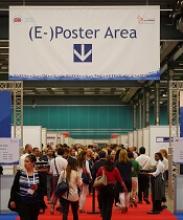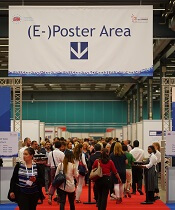User login
STOCKHOLM—The alkylating peptide melflufen has demonstrated activity in patients with treatment-resistant multiple myeloma (MM).
In a phase 2 trial, melflufen plus dexamethasone produced an overall response rate (ORR) of 32.1% in MM patients who were refractory to pomalidomide and/or daratumumab and had failed treatment with immunomodulatory drugs (IMiDs) and proteasome inhibitors (PIs).
Nearly all patients experienced an adverse event (AE) related to study treatment, and most of these were hematologic events.
These results, from the ongoing HORIZON trial, were presented at the 23rd Congress of the European Hematology Association (EHA) as abstract PF581.
The research was sponsored by Oncopeptides AB, the company developing melflufen.
“With an increasing number of patients with highly resistant myeloma, there is a real need for additional treatment options based on new mechanisms of action,” said study investigator Paul Richardson, MD, of the Dana-Farber Cancer Institute in Boston, Massachusetts.
“[Melflufen], a peptidase-enhanced compound, with its potent activity, manageable tolerability, and lack of shared resistance mechanisms with other modalities, is a promising molecule that is making encouraging progress in clinical development.”
Patients and treatment
The data presented at EHA include 62 patients. The data cut-off was May 10, 2018.
The patients had a median age of 62.5 (range, 41-82), 54% had high-risk cytogenetics, and 46% were ISS stage III. The patients had a median of 5.5 prior lines of therapy, and their median time since initial diagnosis was 6.1 years.
All patients were refractory to pomalidomide or daratumumab, 56% were refractory to both drugs, and 89% were double-refractory to IMiDs and PIs. Ninety-eight percent of patients had disease progression on or within 60 days of completing their last therapy.
Patients received melflufen at 40 mg (intravenously over 30 minutes) on day 1 of each 28-day cycle. They also received dexamethasone at 40 mg weekly. Patients were treated until disease progression, unacceptable toxicity, or withdrawal of consent.
At the data cutoff, 49 patients (79%) had completed at least 2 cycles of melflufen. The median number of cycles was 2 (range, 1-11).
Twenty-one patients (34%) were still receiving study treatment at the data cutoff. Reasons for discontinuation included disease progression (47%), AEs (15%), and physician decision (3%). One discontinuation was due to patient request.
Results
Fifty-six patients received at least 1 dose of melflufen and were evaluable for response.
The ORR was 32.1%, and the clinical benefit rate was 39.3%. ORR was defined as partial response (PR) or better, and clinical benefit rate was defined as minor response or better.
Two percent of patients had a complete response, 9% had a very good PR, 21% had a PR, and 7% had a minor response. Forty-five percent of patients had stable disease, and 16% progressed.
Subgroup analyses showed that response didn’t vary across refractory subsets, but it did vary according to the underlying disease and health status of the patient.
Treatment-related AEs occurred in 97% of all patients (60/62), and grade 3/4 treatment-related AEs occurred in 77% (n=48).
Grade 3/4 treatment-related AEs included neutropenia (60%), thrombocytopenia (60%), anemia (31%), leukopenia (6%), lymphopenia (6%), febrile neutropenia (6%), and infections (6%).
Twenty-one percent of patients had at least 1 treatment-related serious AE. The most frequent were febrile neutropenia (6%) and pneumonia (3%).
There were no treatment-related deaths.
STOCKHOLM—The alkylating peptide melflufen has demonstrated activity in patients with treatment-resistant multiple myeloma (MM).
In a phase 2 trial, melflufen plus dexamethasone produced an overall response rate (ORR) of 32.1% in MM patients who were refractory to pomalidomide and/or daratumumab and had failed treatment with immunomodulatory drugs (IMiDs) and proteasome inhibitors (PIs).
Nearly all patients experienced an adverse event (AE) related to study treatment, and most of these were hematologic events.
These results, from the ongoing HORIZON trial, were presented at the 23rd Congress of the European Hematology Association (EHA) as abstract PF581.
The research was sponsored by Oncopeptides AB, the company developing melflufen.
“With an increasing number of patients with highly resistant myeloma, there is a real need for additional treatment options based on new mechanisms of action,” said study investigator Paul Richardson, MD, of the Dana-Farber Cancer Institute in Boston, Massachusetts.
“[Melflufen], a peptidase-enhanced compound, with its potent activity, manageable tolerability, and lack of shared resistance mechanisms with other modalities, is a promising molecule that is making encouraging progress in clinical development.”
Patients and treatment
The data presented at EHA include 62 patients. The data cut-off was May 10, 2018.
The patients had a median age of 62.5 (range, 41-82), 54% had high-risk cytogenetics, and 46% were ISS stage III. The patients had a median of 5.5 prior lines of therapy, and their median time since initial diagnosis was 6.1 years.
All patients were refractory to pomalidomide or daratumumab, 56% were refractory to both drugs, and 89% were double-refractory to IMiDs and PIs. Ninety-eight percent of patients had disease progression on or within 60 days of completing their last therapy.
Patients received melflufen at 40 mg (intravenously over 30 minutes) on day 1 of each 28-day cycle. They also received dexamethasone at 40 mg weekly. Patients were treated until disease progression, unacceptable toxicity, or withdrawal of consent.
At the data cutoff, 49 patients (79%) had completed at least 2 cycles of melflufen. The median number of cycles was 2 (range, 1-11).
Twenty-one patients (34%) were still receiving study treatment at the data cutoff. Reasons for discontinuation included disease progression (47%), AEs (15%), and physician decision (3%). One discontinuation was due to patient request.
Results
Fifty-six patients received at least 1 dose of melflufen and were evaluable for response.
The ORR was 32.1%, and the clinical benefit rate was 39.3%. ORR was defined as partial response (PR) or better, and clinical benefit rate was defined as minor response or better.
Two percent of patients had a complete response, 9% had a very good PR, 21% had a PR, and 7% had a minor response. Forty-five percent of patients had stable disease, and 16% progressed.
Subgroup analyses showed that response didn’t vary across refractory subsets, but it did vary according to the underlying disease and health status of the patient.
Treatment-related AEs occurred in 97% of all patients (60/62), and grade 3/4 treatment-related AEs occurred in 77% (n=48).
Grade 3/4 treatment-related AEs included neutropenia (60%), thrombocytopenia (60%), anemia (31%), leukopenia (6%), lymphopenia (6%), febrile neutropenia (6%), and infections (6%).
Twenty-one percent of patients had at least 1 treatment-related serious AE. The most frequent were febrile neutropenia (6%) and pneumonia (3%).
There were no treatment-related deaths.
STOCKHOLM—The alkylating peptide melflufen has demonstrated activity in patients with treatment-resistant multiple myeloma (MM).
In a phase 2 trial, melflufen plus dexamethasone produced an overall response rate (ORR) of 32.1% in MM patients who were refractory to pomalidomide and/or daratumumab and had failed treatment with immunomodulatory drugs (IMiDs) and proteasome inhibitors (PIs).
Nearly all patients experienced an adverse event (AE) related to study treatment, and most of these were hematologic events.
These results, from the ongoing HORIZON trial, were presented at the 23rd Congress of the European Hematology Association (EHA) as abstract PF581.
The research was sponsored by Oncopeptides AB, the company developing melflufen.
“With an increasing number of patients with highly resistant myeloma, there is a real need for additional treatment options based on new mechanisms of action,” said study investigator Paul Richardson, MD, of the Dana-Farber Cancer Institute in Boston, Massachusetts.
“[Melflufen], a peptidase-enhanced compound, with its potent activity, manageable tolerability, and lack of shared resistance mechanisms with other modalities, is a promising molecule that is making encouraging progress in clinical development.”
Patients and treatment
The data presented at EHA include 62 patients. The data cut-off was May 10, 2018.
The patients had a median age of 62.5 (range, 41-82), 54% had high-risk cytogenetics, and 46% were ISS stage III. The patients had a median of 5.5 prior lines of therapy, and their median time since initial diagnosis was 6.1 years.
All patients were refractory to pomalidomide or daratumumab, 56% were refractory to both drugs, and 89% were double-refractory to IMiDs and PIs. Ninety-eight percent of patients had disease progression on or within 60 days of completing their last therapy.
Patients received melflufen at 40 mg (intravenously over 30 minutes) on day 1 of each 28-day cycle. They also received dexamethasone at 40 mg weekly. Patients were treated until disease progression, unacceptable toxicity, or withdrawal of consent.
At the data cutoff, 49 patients (79%) had completed at least 2 cycles of melflufen. The median number of cycles was 2 (range, 1-11).
Twenty-one patients (34%) were still receiving study treatment at the data cutoff. Reasons for discontinuation included disease progression (47%), AEs (15%), and physician decision (3%). One discontinuation was due to patient request.
Results
Fifty-six patients received at least 1 dose of melflufen and were evaluable for response.
The ORR was 32.1%, and the clinical benefit rate was 39.3%. ORR was defined as partial response (PR) or better, and clinical benefit rate was defined as minor response or better.
Two percent of patients had a complete response, 9% had a very good PR, 21% had a PR, and 7% had a minor response. Forty-five percent of patients had stable disease, and 16% progressed.
Subgroup analyses showed that response didn’t vary across refractory subsets, but it did vary according to the underlying disease and health status of the patient.
Treatment-related AEs occurred in 97% of all patients (60/62), and grade 3/4 treatment-related AEs occurred in 77% (n=48).
Grade 3/4 treatment-related AEs included neutropenia (60%), thrombocytopenia (60%), anemia (31%), leukopenia (6%), lymphopenia (6%), febrile neutropenia (6%), and infections (6%).
Twenty-one percent of patients had at least 1 treatment-related serious AE. The most frequent were febrile neutropenia (6%) and pneumonia (3%).
There were no treatment-related deaths.

